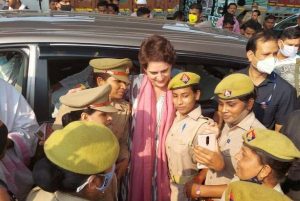India’s Congress party has announced that women will comprise 40 percent of the candidates it will field in the upcoming assembly elections in Uttar Pradesh.
Making the announcement at a press conference in Lucknow on Wednesday, Congress general secretary Priyanka Gandhi Vadra said that “the politics of caste and religion can be changed to politics of development only by bringing women into politics.”
Elections to the Uttar Pradesh state assembly are scheduled to take place in February or March 2022.
Uttar Pradesh is India’s most populous state. It is notorious for being lawless, feudal, and patriarchal. Caste and communal violence is rampant here. According to the latest National Crime Records Bureau report, in 2019, Uttar Pradesh alone accounted for almost 15 percent of all registered crimes committed against women in India.
The Congress, which is India’s main opposition party, was in power in Uttar Pradesh till 1989; the support of Muslims, high-caste Brahmins, and Dalits (formerly known as “Untouchables”) helped it win elections. However, with these communities switching support to other parties, the Congress was relegated to the sidelines and has been in the political wilderness in the state for three decades now.
In the last assembly elections in 2017, the party won just seven seats in the 403-seat Uttar Pradesh assembly. In elections to the national parliament in 2019, the Congress managed to secure just one seat from the state, one less than what it got in 2014.
Bereft of the solid backing of any community or caste group, the Congress seems to be eyeing the votes of women, who comprise roughly 46 percent of Uttar Pradesh’s electorate. It is trying to create a women vote-bank in a situation where it has none.
The announcement has created a bit of a buzz. “Truly unprecedented and historic. It is a turning point in Indian politics!” Congress parliamentarian Jairam Ramesh tweeted.
However, whether the Congress strategy of fielding more women will improve the party’s electoral performance remains to be seen. Much will depend on whether it can build a gender identity among women that supersedes their caste and religious identities.
Some have described the Congress’ decision to field 40 percent women in the Uttar Pradesh election as a “bold gamble.”
That would be true if the party would extend this decision to other states like Punjab or Uttarakhand, which will also vote in a few months and where the Congress is a main contender for power. Here in Uttar Pradesh, the Congress is a minor player and so has little to lose by taking a chance by fielding women candidates.
A dismal number of women sit in India’s national and state legislatures. To change this, the Women’s Reservation Bill, which envisages reservation of 33 percent of seats for women in parliament and state legislative assemblies, was introduced in 1996.
But 25 years thereon, this bill is yet to be passed by the lower house of India’s parliament, indicating the deep resistance that setting aside seats for women in legislatures faces from parties and politicians.
While parties like the Samajwadi Party and the Bahujan Samaj Party – both key contenders for power in Uttar Pradesh – have actively obstructed the passage of the Women’s Reservation Bill in parliament, others like the ruling Bharatiya Janata Party and the Congress, while willing to support the bill’s enactment, have not gone far enough to field more women in elections so far.
The Congress has signaled that it is willing to change that in the upcoming Uttar Pradesh election. It is not the first party to make such a move, however. The Trinamool Congress in West Bengal and the Biju Janata Dal in Odisha have done so in recent elections.
The Congress’ announcement on fielding women candidates could bring real change if it could push other parties to follow suit. But it may not be able to do so as it has “made this announcement [with regard to Uttar Pradesh] from a weakened position,” Gilles Verniers, a political science faculty member at the Ashoka University in New Delhi, tweeted.
So has the Congress blundered by deciding to field women in 40 percent of the constituencies in Uttar Pradesh? Not necessarily.
Results from recent elections indicate that more women than men turned out to vote. In the 2017 assembly election in Uttar Pradesh, 59.5 percent of male voters showed up to vote compared to 63.25 percent of female voters.
More importantly, women are performing impressively in elections. In elections to panchayats (elected local bodies) in Uttar Pradesh in July this year, 53.7 percent of the successful candidates were women. Of the 75 district panchayats, 42 elected women presidents, far in excess of 33 percent reservation for women in local bodies.
The winnability of candidates rather than gender empowerment has driven the electoral decisions of India’s political parties and in this, caste and religion have determined candidate choices in elections hitherto.
Recent elections show that, contrary to the fears of India’s patriarchal parties and politicians, women can and do win elections. Fielding more women in elections is not only essential to promote gender equality in India but also could make electoral sense.

































